1081 Study guides, Class notes & Summaries
Looking for the best study guides, study notes and summaries about 1081? On this page you'll find 135 study documents about 1081.
All 135 results
Sort by
 Popular
Popular
-
2023 MATERNITY/OB RN HESI EXIT VERSION 2 (V2) TEST BANK STUDY GUIDE SCREENSHOTS (ALL 55 QUESTIONS & ANSWERS): Next Generation Format ALL 100% CORRECT – GUARANTEED A++
- Exam (elaborations) • 44 pages • 2023
-
- $34.46
- 13x sold
- + learn more
2023 *Authentic* *Real* Student Reviews of our HESI Products (Sample Snippet because we over 1000 reviews) : I used your critical care Hesi to help me study for my hesi final and I got the HIGHEST grade on the hesi I’ve ever got! So thank you so much. I am now beginning my last semester of nursing school, thank God! Thanks so much!! I want to thank you again, I passed my Hesi with a 928. Needed a 850. Hey just wanted to say thank you for the info you sent over I was able to pass...
 Popular
Popular
-
PHARMACOLOGY PN HESI EXIT VERSION 1 (V1) TEST BANK (33 out of 50 & FULL QUESTIONS & WITHOUT ANSWER (SCREENSHOTS- PICS): Next Generation Format ALL 100% CORRECT – GUARANTEED A++
- Exam (elaborations) • 19 pages • 2023 Popular
-
- $24.05
- 4x sold
- + learn more
2024 *Authentic* *Real* Student Reviews of our HESI Products (Sample Snippet because we over 1000 reviews) : I used your critical care Hesi to help me study for my hesi final and I got the HIGHEST grade on the hesi I’ve ever got! So thank you so much. I am now beginning my last semester of nursing school, thank God! Thanks so much!! I want to thank you again, I passed my Hesi with a 928. Needed a 850. Hey just wanted to say thank you for the info you sent over I was able to pass...
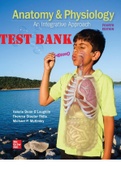
-
TEST BANK for Anatomy & Physiology: An Integrative Approach, 4th Edition, Michael McKinley, Valerie O’Loughlin, Theresa Bidle, All Chapters 1-29 in 1081 Pages
- Other • 1082 pages • 2022
-
- $37.46
- 119x sold
- + learn more
Test Bank for Anatomy & Physiology: An Integrative Approach, 4th Edition, Michael McKinley, Valerie O’Loughlin, Theresa Bidle, ISBN10: 8. Table of Contents 1. The Sciences of Anatomy an d Physiology 2. Atoms, Ions, and Molecules 3. Energy, Chemical Reactions, and Cellular Respiration 4. Biology of the Cell 5. Tissue Organization 6. Integumentary System 7. Skeletal System: Bone Structure and Function 8. Skeletal System: Axial and Appendicular Skeleton 9. Skeletal System: Articulations 10. Musc...
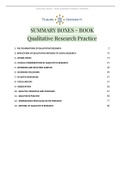
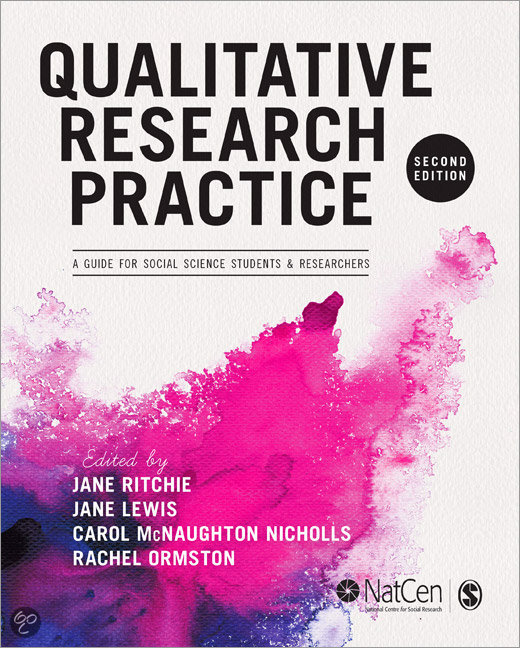
-
Summary book Qualitative Research Practice, ISBN: 9781446209127 MTO-E-MAW: Qualitative Research Methods (441081-B-6)
- Summary • 88 pages • 2022
-
Available in package deal
-
- $6.82
- 9x sold
- + learn more
COMPLETE summary of the book of all the important boxes, key points and key terms of the book Qualitative Research Practice : A Guide for Social Science Students and Researchers. Sorted by chapter.
Alle stof die je moet weten voor het tentamen. Alle colleges uitgewerkt + aanvullende informatie uit papers.

-
TEST BANK FOR BRUNNER AND SUDDARTH’S TEXTBOOK OF MEDICAL SURGICAL NURSING 15TH EDITION COMPLETE SET CH1-68 | REAL EXAM QUESTIONS WITH CORRECT EXPERT VERIFIED ANSWERS | LATEST UPDATE | ALREADY PASSED
- Exam (elaborations) • 1981 pages • 2023
-
Available in package deal
-
- $15.99
- 3x sold
- + learn more
TEST BANK FOR BRUNNER AND SUDDARTH’S TEXTBOOK OF MEDICAL SURGICAL NURSING 15TH EDITION COMPLETE SET CH1-68 | REAL EXAM QUESTIONS WITH CORRECT EXPERT VERIFIED ANSWERS | LATEST UPDATE | ALREADY PASSED Test Bank - Brunner Suddarth Medical Surgical Nursing (15th by Hinkle) 1 Downloaded by Ned Toyn () Table of Contents Table of Contents 1 Chapter 01: Professional Nursing Practice Chapter 02: Medical-Surgical Nursing Chapter 03: Health Education and Promotion Chapter 04: Adult ...
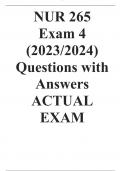
-
NUR 265 Exam 4 (2023/2024) Questions with Answers ACTUAL EXAM
- Exam (elaborations) • 10 pages • 2023
-
Available in package deal
-
- $17.49
- 3x sold
- + learn more
NUR 265 - Exam 4 Questions with Answers. The nurse working in the ED is triaging a client who has presented with chest pain, shortness of breath, a productive cough, and reports nights sweats. That clients health history includes the presence of acquired immunodeficiency syndrome (AIDS) and the recent laboratory results that reveal a low CD4+ count. Airborne precautions have been initiated. Which of the following actions should the nurse take next? RATIONALE: A fever is a symptom of AIDS ...
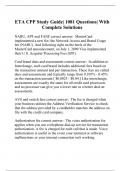
-
ETA CPP Study Guide| 1081 Questions| With Complete Solutions
- Exam (elaborations) • 177 pages • 2023
-
Available in package deal
-
- $27.99
- + learn more
NABU, APF and FANF correct answer: MasterCard implemented a new fee, the Network Access and Brand Usage fee (NABU). And following right on the heels of the MasterCard announcement, on July 1, 2009 Visa implemented their U.S. Acquirer Processing Fee (APF). Card brand dues and assessments correct answer: In addition to Interchange, each card brand includes additional fees based on the transaction amount and per transaction. These fees are called dues and assessments and typically range from 0...

-
2023 Fundamentals Exit Hesi Exit Exam Test Bank (All 55 Q&A) Included Guaranteed A++. Scored 1081 – Exam. Taken Sept. 26th, 2023
- Exam (elaborations) • 19 pages • 2024
-
- $17.99
- + learn more
2023 Fundamentals Exit Hesi Exit Exam Test Bank (All 55 Q&A) Included Guaranteed A++. Scored 1081 – Exam. Taken Sept. 26th, 2023 2023 Fundamentals Exit Hesi Exit Exam Test Bank (All 55 Q&A) Included Guaranteed A++. Scored 1081 – Exam. Taken Sept. 26th, 2023
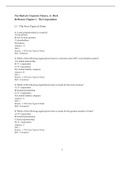
-
Test Bank for Corporate Finance, 5th Edition by Jonathan Berk
- Exam (elaborations) • 986 pages • 2022
-
- $39.99
- 11x sold
- + learn more
Test Bank for Corporate Finance 5e 5th Edition by Jonathan Berk, Peter DeMarzo. ISBN-13: 1081 Full chapters test bank PDF PART 1: INTRODUCTION 1. The Corporation and Financial Markets 2. Introduction to Financial Statement Analysis 3. Financial Decision Making and the Law of One Price PART II: TIME, MONEY, AND INTEREST RATES 4. The Time Value of Money 5. Interest Rates 6. Valuing Bonds PART III: VALUING PROJECTS AND FIRMS 7. Investment Decision Rules 8. Fundam...

Did you know that on average a seller on Stuvia earns $82 per month selling study resources? Hmm, hint, hint. Discover all about earning on Stuvia



